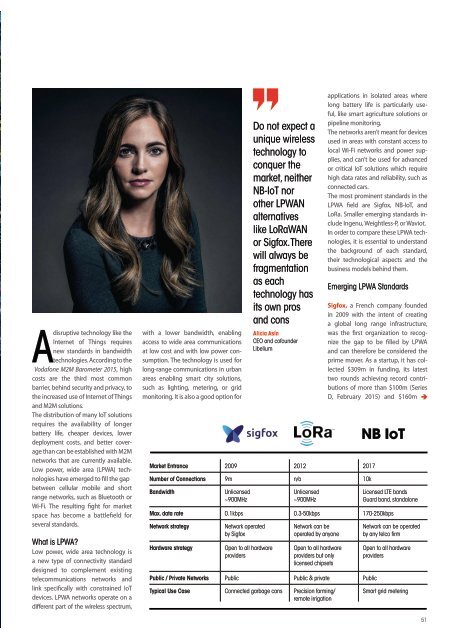Smart Industry 1/2017
Smart Industry 1/2017 - The IoT Business Magazine - powered by Avnet Silica
Smart Industry 1/2017 - The IoT Business Magazine - powered by Avnet Silica
Create successful ePaper yourself
Turn your PDF publications into a flip-book with our unique Google optimized e-Paper software.
A<br />
disruptive technology like the<br />
Internet of Things requires<br />
new standards in bandwidth<br />
technologies. According to the<br />
Vodafone M2M Barometer 2015, high<br />
costs are the third most common<br />
barrier, behind security and privacy, to<br />
the increased use of Internet of Things<br />
and M2M solutions.<br />
The distribution of many IoT solutions<br />
requires the availability of longer<br />
battery life, cheaper devices, lower<br />
deployment costs, and better coverage<br />
than can be established with M2M<br />
networks that are currently available.<br />
Low power, wide area (LPWA) technologies<br />
have emerged to fill the gap<br />
between cellular mobile and short<br />
range networks, such as Bluetooth or<br />
Wi-Fi. The resulting fight for market<br />
space has become a battlefield for<br />
several standards.<br />
What is LPWA?<br />
Low power, wide area technology is<br />
a new type of connectivity standard<br />
designed to complement existing<br />
tele communications networks and<br />
link specifically with constrained IoT<br />
devices. LPWA networks operate on a<br />
different part of the wireless spectrum,<br />
with a lower bandwidth, enabling<br />
access to wide area communications<br />
at low cost and with low power consumption.<br />
The technology is used for<br />
long-range communications in urban<br />
areas enabling smart city solutions,<br />
such as lighting, metering, or grid<br />
monitoring. It is also a good option for<br />
applications in isolated areas where<br />
long battery life is particularly useful,<br />
like smart agriculture solutions or<br />
pipeline monitoring.<br />
The networks aren’t meant for devices<br />
used in areas with constant access to<br />
local Wi-Fi networks and power supplies,<br />
and can’t be used for advanced<br />
or critical IoT solutions which require<br />
high data rates and reliability, such as<br />
connected cars.<br />
The most prominent standards in the<br />
LPWA field are Sigfox, NB-IoT, and<br />
LoRa. Smaller emerging standards include<br />
Ingenu, Weightless-P, or Waviot.<br />
In order to compare these LPWA technologies,<br />
it is essential to understand<br />
the background of each standard,<br />
their technological aspects and the<br />
business models behind them.<br />
Emerging LPWA Standards<br />
Market Entrance 2009 2012 <strong>2017</strong><br />
Number of Connections 9m n/a 10k<br />
Bandwidth<br />
Unlicensed<br />
~900MHz<br />
Unlicensed<br />
~900MHz<br />
Sigfox, a French company founded<br />
in 2009 with the intent of creating<br />
a global long range infrastructure,<br />
was the first organization to recognize<br />
the gap to be filled by LPWA<br />
and can therefore be considered the<br />
prime mover. As a startup, it has collected<br />
$309m in funding, its latest<br />
two rounds achieving record contributions<br />
of more than $100m (Series<br />
D, February 2015) and $160m<br />
Licensed LTE bands<br />
Guard band, standalone<br />
Max. data rate 0.1kbps 0.3-50kbps 170-250kbps<br />
Network strategy<br />
Hardware strategy<br />
Network operated<br />
by Sigfox<br />
Open to all hardware<br />
providers<br />
Do not expect a<br />
unique wireless<br />
technology to<br />
conquer the<br />
market, neither<br />
NB-IoT nor<br />
other LPWAN<br />
alternatives<br />
like LoRaWAN<br />
or Sigfox. There<br />
will always be<br />
fragmentation<br />
as each<br />
technology has<br />
its own pros<br />
and cons<br />
Alicia Asín<br />
CEO and cofounder<br />
Libelium<br />
Network can be<br />
operated by anyone<br />
Open to all hardware<br />
providers but only<br />
licensed chipsets<br />
Public / Private Networks Public Public & private Public<br />
Typical Use Case Connected garbage cans Precision farming/<br />
remote irrigation<br />
NB IoT<br />
Network can be operated<br />
by any telco firm<br />
Open to all hardware<br />
providers<br />
<strong>Smart</strong> grid metering<br />
51

















